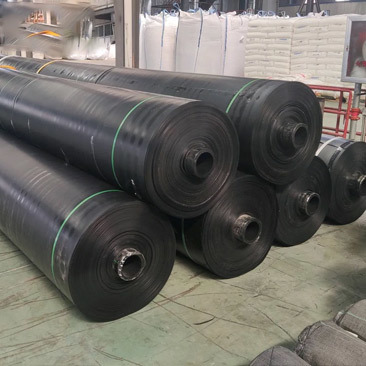Exploring the Future Trends in Composite Geomembrane Usage: A Comprehensive Insight
Release time:
2025-09-18
Exploring the Future Trends in Composite Geomembrane Usage Table of Contents 1. Introduction to Composite Geomembranes 2. Understanding Geosynthetics and Their Role in Construction 3. Key Applications of Composite Geomembranes 4. Emerging Trends in Composite Geomembrane Technologies 5. Sustainability in Geomembrane Design and Usage 6. Future Challenges and Opportunities in
Exploring the Future Trends in Composite Geomembrane Usage
Table of Contents
- 1. Introduction to Composite Geomembranes
- 2. Understanding Geosynthetics and Their Role in Construction
- 3. Key Applications of Composite Geomembranes
- 4. Emerging Trends in Composite Geomembrane Technologies
- 5. Sustainability in Geomembrane Design and Usage
- 6. Future Challenges and Opportunities in the Geomembrane Industry
- 7. Frequently Asked Questions
- 8. Conclusion
1. Introduction to Composite Geomembranes
Composite geomembranes have become increasingly vital in various industries due to their unique properties and versatility. These materials consist of two or more layers, typically combining a polymeric layer with a geotextile. This configuration enhances strength, durability, and flexibility, making them suitable for a wide range of applications, including landfill liners, water containment, and environmental protection projects.
As we explore the future trends in composite geomembrane usage, it's essential to understand the current landscape of materials and technologies driving these innovations.
2. Understanding Geosynthetics and Their Role in Construction
Geosynthetics encompass a broad range of synthetic materials used in geotechnical engineering and construction. These products include geomembranes, geotextiles, geogrids, and more. Their primary functions involve separation, reinforcement, filtration, and drainage.
**Composite geomembranes** serve as a critical component in this realm. Their layered structure provides enhanced functionality, allowing for improved resistance to environmental factors such as UV radiation, chemical exposure, and punctures. As the construction industry increasingly prioritizes sustainability and efficiency, the demand for advanced geosynthetic products like composite geomembranes is on the rise.
3. Key Applications of Composite Geomembranes
Composite geomembranes are employed in various sectors, each application highlighting their unique benefits.
3.1 Landfill Liners
One of the most common applications is in landfill liners, where composite geomembranes effectively prevent leachate from contaminating groundwater. The combination of a robust polymer layer and a geotextile enhances the liner's durability, ensuring long-term performance under challenging conditions.
3.2 Water Reservoirs
In water management systems, composite geomembranes are utilized to line reservoirs and ponds, preventing water loss through seepage. Their resistance to UV degradation and chemical attack ensures they remain effective over time, safeguarding valuable water resources.
3.3 Mining Operations
The mining industry also benefits from composite geomembranes, which are used in tailings management and leachate collection systems. The strength and flexibility of these materials help manage the environmental impact of mining operations, promoting sustainable practices.
3.4 Agricultural Applications
In agriculture, composite geomembranes are employed in irrigation systems and agricultural ponds. Their impermeable nature ensures efficient water retention, while the geotextile layer can provide additional benefits such as erosion control.
4. Emerging Trends in Composite Geomembrane Technologies
The landscape of composite geomembrane usage is rapidly evolving, with several trends shaping the future.
4.1 Advancements in Material Science
Recent advancements in polymer technology have led to the development of more resilient composite geomembranes. Innovations such as nanotechnology and bio-based polymers are driving improvements in strength, flexibility, and environmental resistance.
4.2 Smart Geomembranes
The integration of smart technology into geomembranes is an emerging trend. Sensors embedded within composite materials can monitor environmental conditions, providing real-time data on stress, moisture levels, and potential leaks. This innovation allows for proactive maintenance and risk management.
4.3 Customization and Tailored Solutions
As project requirements become more complex, the demand for customized geomembrane solutions is increasing. Manufacturers are beginning to offer tailored products that meet specific project needs, enhancing efficiency and performance.
4.4 Increased Focus on Sustainability
Sustainability is becoming a central theme in the geomembrane industry. Manufacturers are exploring eco-friendly materials and production processes to reduce their carbon footprint. The use of recycled materials in composite geomembranes is a trend that is gaining traction, offering a viable alternative to traditional products.
5. Sustainability in Geomembrane Design and Usage
The push for sustainability in the construction industry extends to composite geomembranes. As environmental concerns heighten, industry stakeholders are increasingly aware of the need for eco-friendly solutions.
5.1 Life Cycle Assessment (LCA)
Implementing Life Cycle Assessment (LCA) methodologies helps evaluate the environmental impact of geomembrane products throughout their life cycle, from production to disposal. This analysis aids manufacturers in making informed decisions that prioritize sustainability.
5.2 Biodegradable Options
Research into biodegradable composite geomembranes is a promising trend. These materials would decompose under specific environmental conditions, significantly reducing landfill waste and environmental impact.
5.3 Energy-Efficient Production Processes
Manufacturers are adopting energy-efficient production processes to minimize energy consumption and greenhouse gas emissions. By using renewable energy sources and optimizing manufacturing techniques, the industry can significantly reduce its environmental footprint.
6. Future Challenges and Opportunities in the Geomembrane Industry
While the future of composite geomembranes appears promising, certain challenges must be addressed to fully realize their potential.
6.1 Regulatory Compliance
As regulations surrounding environmental protection become more stringent, geomembrane manufacturers must ensure compliance with various standards. This challenge necessitates continuous innovation and adaptation to maintain product efficacy while adhering to regulations.
6.2 Market Competition
The geomembrane market is becoming increasingly competitive, with numerous players vying for market share. Companies must differentiate themselves through innovation, quality, and customer service to succeed in this dynamic landscape.
6.3 Technological Integration
Integrating advanced technologies into geomembrane products poses both opportunities and challenges. While the potential for smart geomembranes is significant, manufacturers must invest in research and development to bring these innovations to market successfully.
7. Frequently Asked Questions
7.1 What are composite geomembranes?
Composite geomembranes are materials made from multiple layers, typically combining a polymeric layer with geotextiles to enhance strength and performance in various applications.
7.2 How are composite geomembranes used in landfills?
In landfills, composite geomembranes serve as liners to prevent leachate from contaminating the surrounding environment, ensuring effective waste management and environmental protection.
7.3 What are some emerging trends in geomembrane technology?
Emerging trends include advancements in material science, the integration of smart technology, customization of products, and an increased focus on sustainability.
7.4 Can composite geomembranes be customized for specific projects?
Yes, manufacturers are increasingly offering tailored solutions that meet the unique requirements of specific projects, enhancing performance and efficiency.
7.5 What are the sustainability practices in geomembrane production?
Sustainability practices include the use of recycled materials, energy-efficient production processes, and the exploration of biodegradable options for composite geomembranes.
8. Conclusion
The future of composite geomembrane usage is rife with potential, driven by innovations in materials, emerging technologies, and a growing emphasis on sustainability. As industries continue to evolve, staying abreast of these trends is essential for professionals in the construction and environmental sectors. Embracing these advancements will not only enhance project outcomes but also contribute to a more sustainable future for our planet. As we look ahead, the role of composite geomembranes will undoubtedly expand, offering new solutions to the challenges of modern construction and environmental protection.






